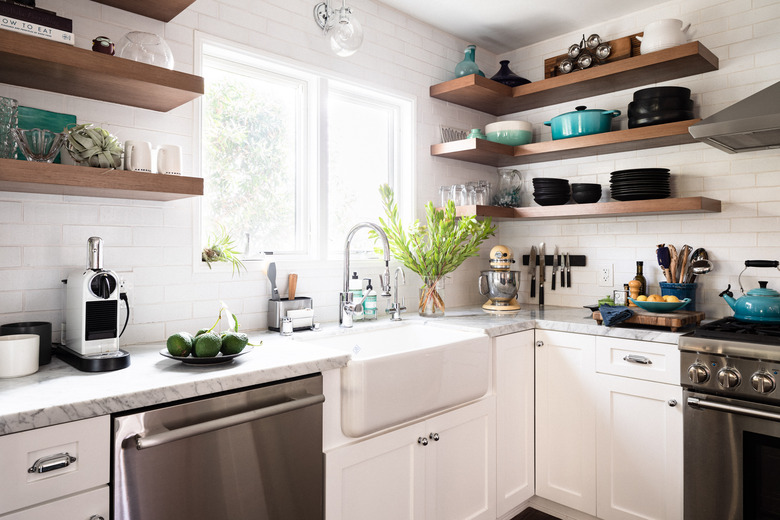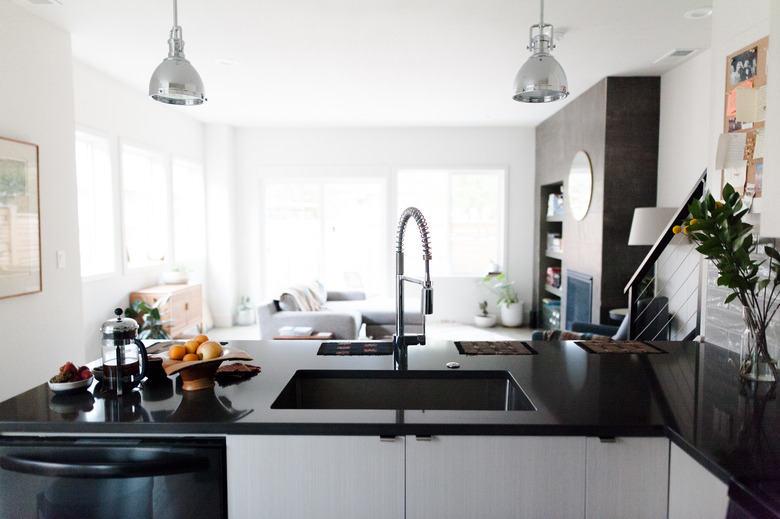What Is A Pull-Down Kitchen Faucet?
We may receive a commission on purchases made from links.
A pull-down kitchen faucet offers distinctive styling as well as functionality not found in traditional faucets. The clean design unclutters the sink deck by doing away with a separate faucet and spray head.
When compared with other types of faucets, pull-down kitchen faucets are relatively new. The development has given faucet manufacturers the opportunity to develop new looks and designs. In addition, these products provide a vehicle to make use of advances in faucet technology.
Pull-Down Faucet Benefits
Pull-Down Faucet Benefits
A pull-down kitchen faucet resembles a goose-neck faucet because of its tall, rounded spout, but most models don't curve as much as a traditional goose-neck faucet. These faucets have a very appealing design that makes them a favorite of kitchen designers and homeowners who want to remodel their kitchens by upgrading their faucets.
The high arc, which is usually in the 10- to 12-inch range, makes it a good candidate for filling and washing large pots. On many models, the spout swivels. That means you have the option of working it like a traditional faucet, or you can pull down on the spout head to move the spray head anywhere you wish.
On most models, the hose is long enough so that you can reach into the corners of the largest kitchen sink, and you can pull the spray head to the countertop to fill pots. When finished, the spray hose retracts back into the spout. A weight attached to the hose under the sink helps the spray head retract into position. Some faucets have magnets installed in the spray head and the spout to keep the spray head docked securely. Magnetic docking (manufacturers all have proprietary names for it) prevents dangling spray heads.
Pull-down faucets usually have multifunction spray heads that range from regular faucet flow to sprays of varying intensity. These are controlled by buttons or switches in the spray head. All of these faucets have single-lever operation, so they are easy to operate for most people, including many who have limited mobility in their hands.
High-end models feature hands-free or touchless operation, where you simply touch the faucet to turn it on or off, or there are sensors on the faucet spout that react to motion. Batteries installed under the sink supply the power. Using hands-free operation means that when you turn on the water flow, the temperature will be the same as when you last used the faucet. Many models have a series of indicator lights that alert you to high water temperatures.
One of the newest features is voice-activated pull-down kitchen faucets, such as Delta's Voice IQ, which is linked to a home assistant like Amazon's Alexa or Google Assistant. Your voice can turn the faucet on and off and dispense specific amounts of water when you need it.
Pull-Down vs. Pull-Out Faucets
Pull-Down vs. Pull-Out Faucets
Many people confuse pull-down kitchen faucets with pull-out faucet models. They both achieve the goal of removing the spray attachment from the sink deck and making it part of the faucet spout, but they do it in different ways.
Pull-Down Faucets
- Curved spout
- Pulls down towards the sink
- Best for larger spaces
Pull-Out Faucets
- Low-profile spout
- Pulls out towards the user
- Ideal for small spaces
Additionally, proponents of the pull-down kitchen faucet say the pulling-down motion is more ergonomic than the pulling-out motion. Removing and using the pull-down spray head involves one natural motion. Using a pull-out faucet means many people will grasp the spray head and then shift their grip to operate it. For most people, that is probably a small consideration, but for someone with limited mobility, the pull-down version may make the most sense because it is easier to use.
Choosing a Pull-Down Faucet
Choosing a Pull-Down Faucet
The working parts of faucets are made of solid brass, stainless steel, plastic, or zinc alloy, which is a combination of metals. Brass and stainless steel faucets are the most durable and trouble-free. They also tend to be more expensive than faucets made from less-expensive materials.
For the most part, the old compression valves that relied on washers to stop leaks have been replaced by cartridge-style valves. They are more reliable, and they tend to be easier to repair than the old washer style. On some of the most reliable valves, ceramic disks regulate the flow of water.
It used to be that chrome and brass were the only finishes available for kitchen faucets. That has changed dramatically. Now there are variations of the originals, such as brushed chrome and brass as well as stainless steel, brushed nickel, bronze, and powder-coated faucets in different colors. Matte black finishes are very popular right now and blend well with contemporary designs.
When selecting a pull-down kitchen faucet, match the shape and style of the faucet to the design of the rest of the kitchen. You'll find everything from traditional styles to very contemporary designs. One type tries to mimic restaurant kitchen design. The pull-down hose is surrounded by what looks like a coiled spring, leaving the hose mostly exposed for its entire length.
Pull-down faucets range in price from about $100 to over $950. Better-quality faucets cost more, such as those with braided nylon or braided stainless steel sheathing on the hoses. Extras like hands-free operation drive up the price.
Tip
Although it is not always possible, it is best to handle the faucets when shopping. The hose will get a lot of use and abuse over the years, so you want to make sure you get a quality product.
Pull-Down Kitchen Faucet General Installation Tips
Pull-Down Kitchen Faucet General Installation Tips
A pull-down kitchen faucet is installed much the same way as any other faucet. If you want to replace or install a faucet yourself, keep in mind that there are some extra considerations with a pull-down faucet.
If you are installing a sink at the same time, try to make as many faucet connections to the sink as possible before setting the sink in place. Securing the faucet to the sink deck is much easier with the sink on top of the counter than when the sink is in place.
Pull-Down Faucet Installation
Pull-Down Faucet Installation
Pull-down faucets require one hole in the sink. If your drop-in sink has two or three holes, check the faucet manufacturer's literature. In most cases, these faucets come with a base or deck plate that matches the faucet's finish and covers the unused holes.
One of the differences between installing a pull-down faucet and other types is dealing with the pull-down hose. In most cases, once the faucet is in place, you thread the hose through the outlet of the spout and into the works under the sink. Installation usually involves attaching the spray head to the hose once the hose is in position.
The hot and cold water supply lines run up into the faucet body, where they are attached to the mixing valve. Hanging down from this assembly is an outlet hose. The pull-down hose and the outlet hose are attached under the sink. The final step is to attach a small weight to the pull-down hose. The weight helps retract the hose when not in use.
Tip
For hands-free faucets, installation gets a little trickier. There's a small control box that has to be mounted to the wall or the underside of the sink. The water supply flows through the box, and a short data cable connects the faucet to the controls. There may also be a separate battery pack that will be mounted nearby and plugged into the control box. Manufacturer's directions are generally clear on the installation steps, but working in the cramped space makes the installation difficult.
Maintaining Your Pull-Down Faucet
Maintaining Your Pull-Down Faucet
When in doubt about how to keep your pull-down faucet clean, consult the manufacturer's recommendations. It's the best way to maintain your specific faucet, and if you ignore them and something happens, the manufacturer can void the product's warranty. Some manufacturers sell faucet cleaners designed for the finishes of their products.
For general cleaning, use a mild soap and warm water. In most cases, harsh detergents, abrasive sponges, and items like steel wool will harm the finish. Some green, fibrous pads often contain microscopic particles that can scratch the finish.
Whatever you use to clean the finish, follow by rinsing with clean water and drying with a soft cloth. Blotting the faucet dry helps prevent water spots on some finishes. Some finishes also benefit from a light coating of wax, such as car wax. Check with the manufacturer first and be aware that the wax could change the color slightly.
In areas where hard water is common, mineral deposits, also called limescale, can build up around faucets, especially around the base and the spout. This white material is caused by calcium and metals that are in the water. To remove the buildup, follow these steps (if approved by your faucet manufacturer):
- Use equal parts of white vinegar and water.
- Soak a cloth in the solution and apply it to the buildup.
- Try to mold the cloth around the faucet, making sure it is in contact with the mineral deposits.
- Leave the cloth on for about one hour.
The buildup will often disappear using this technique. If it does not, try removing what is left by rubbing it with a soft cloth soaked in the solution. When finished, rinse the area with clean water and dry with a soft cloth.


